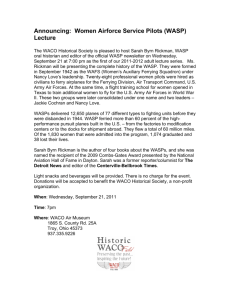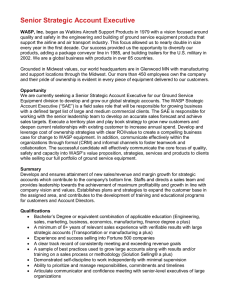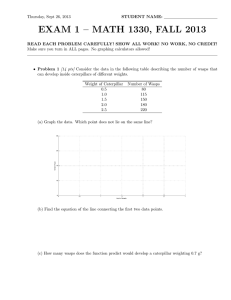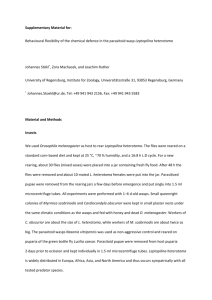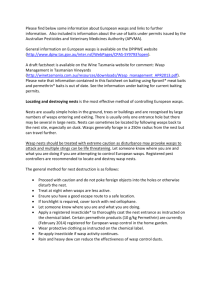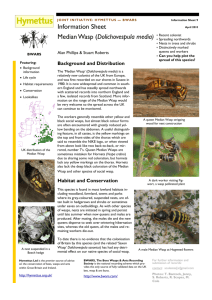Better Parasitic Wasps for Biological Control Bacterial symbionts make a difference
advertisement
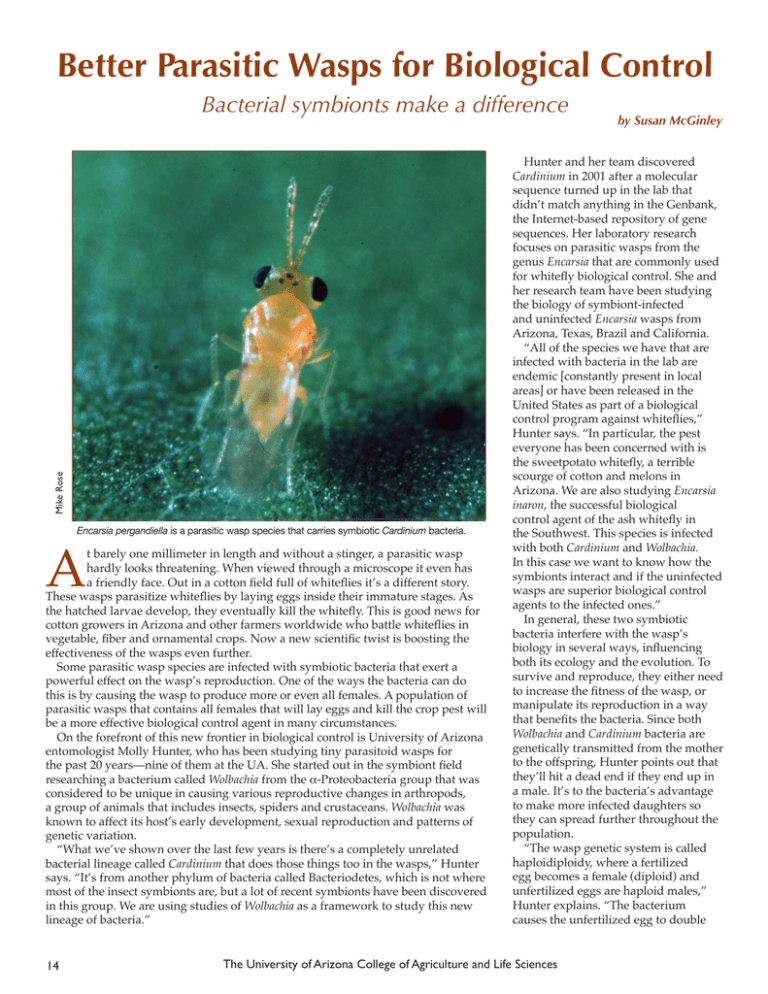
Better Parasitic Wasps for Biological Control Mike Rose Bacterial symbionts make a difference Encarsia pergandiella is a parasitic wasp species that carries symbiotic Cardinium bacteria. A t barely one millimeter in length and without a stinger, a parasitic wasp hardly looks threatening. When viewed through a microscope it even has a friendly face. Out in a cotton field full of whiteflies it’s a different story. These wasps parasitize whiteflies by laying eggs inside their immature stages. As the hatched larvae develop, they eventually kill the whitefly. This is good news for cotton growers in Arizona and other farmers worldwide who battle whiteflies in vegetable, fiber and ornamental crops. Now a new scientific twist is boosting the effectiveness of the wasps even further. Some parasitic wasp species are infected with symbiotic bacteria that exert a powerful effect on the wasp’s reproduction. One of the ways the bacteria can do this is by causing the wasp to produce more or even all females. A population of parasitic wasps that contains all females that will lay eggs and kill the crop pest will be a more effective biological control agent in many circumstances. On the forefront of this new frontier in biological control is University of Arizona entomologist Molly Hunter, who has been studying tiny parasitoid wasps for the past 20 years—nine of them at the UA. She started out in the symbiont field researching a bacterium called Wolbachia from the α-Proteobacteria group that was considered to be unique in causing various reproductive changes in arthropods, a group of animals that includes insects, spiders and crustaceans. Wolbachia was known to affect its host’s early development, sexual reproduction and patterns of genetic variation. “What we’ve shown over the last few years is there’s a completely unrelated bacterial lineage called Cardinium that does those things too in the wasps,” Hunter says. “It’s from another phylum of bacteria called Bacteriodetes, which is not where most of the insect symbionts are, but a lot of recent symbionts have been discovered in this group. We are using studies of Wolbachia as a framework to study this new lineage of bacteria.” 14 by Susan McGinley Hunter and her team discovered Cardinium in 2001 after a molecular sequence turned up in the lab that didn’t match anything in the Genbank, the Internet-based repository of gene sequences. Her laboratory research focuses on parasitic wasps from the genus Encarsia that are commonly used for whitefly biological control. She and her research team have been studying the biology of symbiont-infected and uninfected Encarsia wasps from Arizona, Texas, Brazil and California. “All of the species we have that are infected with bacteria in the lab are endemic [constantly present in local areas] or have been released in the United States as part of a biological control program against whiteflies,” Hunter says. “In particular, the pest everyone has been concerned with is the sweetpotato whitefly, a terrible scourge of cotton and melons in Arizona. We are also studying Encarsia inaron, the successful biological control agent of the ash whitefly in the Southwest. This species is infected with both Cardinium and Wolbachia. In this case we want to know how the symbionts interact and if the uninfected wasps are superior biological control agents to the infected ones.” In general, these two symbiotic bacteria interfere with the wasp’s biology in several ways, influencing both its ecology and the evolution. To survive and reproduce, they either need to increase the fitness of the wasp, or manipulate its reproduction in a way that benefits the bacteria. Since both Wolbachia and Cardinium bacteria are genetically transmitted from the mother to the offspring, Hunter points out that they’ll hit a dead end if they end up in a male. It’s to the bacteria’s advantage to make more infected daughters so they can spread further throughout the population. “The wasp genetic system is called haploidiploidy, where a fertilized egg becomes a female (diploid) and unfertilized eggs are haploid males,” Hunter explains. “The bacterium causes the unfertilized egg to double The University of Arizona College of Agriculture and Life Sciences says six to seven percent of all insects have Cardinium, while 20 percent carry Wolbachia. “Multiply that times the number of arthropods, and it’s not such a small number. These interventions are not subtle agents in the lives of the insects. The effects are large.” Classical biological control measures usually involve bringing in an exotic natural enemy of an exotic insect pest, reuniting the specialized natural enemy with its host. As a result, the pest population is often reduced far Her laboratory research focuses on parasitic wasps from the genus Encarsia that are commonly used for whitefly biological control. below damaging levels. Other kinds of biological control focus on rearing and releasing local parasites or predators for shorter term effects. In both of these approaches, the biological control agent must be collected, reared in a lab and released. Hunter believes that knowing what symbiont is present, and what its effects are on the biology of the host wasp or predator, allows us to potentially manage their symbionts: keep them if they’re good for biological control, and get rid of them with antibiotics if they are not. For example, Hunter has been studying a wasp native to Texas that attacks the sweetpotato whitefly. Mike Rose its chromosome count and become a female. Called parthenogenesis (the production of all-female populations) induction, this process is not entirely understood, but it turns the developing male into a female.” Another way the symbiont can work is through a process called cytoplasmic incompatibility, where the bacterial manipulation takes place in males. Males can’t transmit the bacterium; instead the symbiont spreads by sabotaging the reproduction of the uninfected females that mate with these males. Infected females benefit by the misfortune of uninfected females, and become more common in subsequent generations. “In this case, infection is not necessarily bad when every single wasp has the symbiont,” says Steve Perlman, a former postdoctoral student in Hunter’s lab who is now a professor at the University of Victoria, British Columbia. “You have to be careful when not every wasp has it, though, because you’ll have more sick offspring and less effective biological control.” Hunter and her colleagues have shown that Cardinium exhibits both of these mechanisms of reproductive manipulation in Encarsia wasps— parthenogenesis induction and cytoplasmic incompatibility. In mites, it also causes genetic males to develop as females, a process called feminization. These bacteria are not rare, and parasitic wasps appear to be especially prone to infection. Hunter Virtually all of the wasps there are infected with Cardinium that causes cytoplasmic incompatibility. She has found in her laboratory that the wasps infected with the bacteria lay fewer eggs than the uninfected lines; in one case it was 25 percent fewer eggs. She says this is a case where you wouldn’t want the symbiont present. Similarly, another Encarsia wasp containing Cardinium was collected in Brazil and considered to have great potential for sweetpotato whitefly biological control, but despite large-scale releases this species hasn’t been recovered in the field. Hunter believes the symbiont was interfering with the wasp’s survival there as well. Yet in other cases it’s an advantage to release wasps infected with bacterial symbionts. Where wasps are mass reared for release, in greenhouses for example, bacteria that cause parthenogenesis could be beneficial both for the insectary producing the wasps and the grower. “In all-female populations there is no inefficiency because no males are being produced,” Perlman says. “Females don’t need to spend time looking for males to mate with. In this case the name of the game in parasitism is females.” Hunter’s fascination with the waspbacterium relationship has not waned since she began studying it. Over the years she has studied numerous examples of this fundamental interaction and has found a more philosophical approach to working with it. “You can look at this as a strange sexual manipulation of the insect by the bacterium, or is the insect as we know it really more like a committee, a wasp and one or more bacteria housed within one skin?” Hunter asks. “It’s actually possible to think about removing part of the committee, looking at the insect with and without the partner. This offers opportunities for a better understanding of the insect as a whole and also of developing predictive power to increase the efficiency of biological control.” CONTACT Electron micrograph shows Cardinium hertigii bacteria that affect the reproduction of Encarsia wasps. Molly Hunter 520-621-9350 mhunter@cals.arizona.edu 2005 Agricultural Experiment Station Research Report 15
